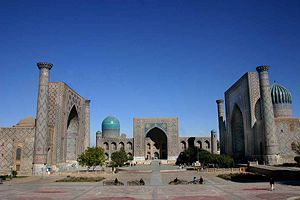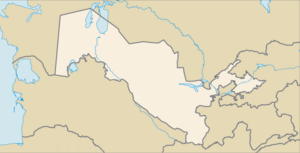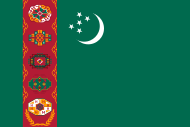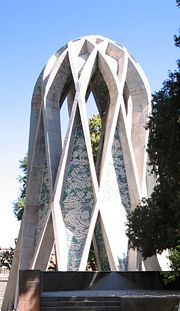Samarkand
| Samarkand | |
 |
|
 Samarkand
|
|
| Coordinates: | |
| Country | |
|---|---|
| Province | Samarqand Province |
| Elevation | 702 m (2,303 ft) |
| Population (2008) | |
| - City | 596,300 |
| - Urban | 643,970 |
| - Metro | 708,000 |
Samarkand (Uzbek: Samarqand, Самарқанд, Persian: سمرقند, UniPers: "Samarqand"), is the second-largest city in Uzbekistan and the capital of Samarqand Province.The city is most noted for its central position on the Silk Road between China and the West, and for being an Islamic centre for scholarly study. The Bibi-Khanym Mosque remains one of the city's most famous landmarks. The Registan was the ancient centre of the city. In 2001, UNESCO inscribed the 2750-year-old city on the World Heritage List as Samarkand - Crossroads of Cultures.
Contents |
Etymology

Samarkand derives its name from the Old Persian asmara, "stone", "rock", and Sogdian kand, "fort", "town".[1]
History
Samarkand was founded by the Persians in the late 6th century BCE and it was one of the main centers of Persian civilization in the ancient times. It is one of the oldest inhabited cities in the world, prospering from its location on the trade route between China and Europe (Silk Road). At times Samarkand has been one of the greatest cities of Central Asia. Founded circa 700 BC it was already the capital of the Sogdian satrapy under the Achaemenid dynasty of Persia when Alexander the Great conquered it in 329 BC (see Afrasiab, Sogdiana).
| Samarkand – Crossroads of Culture* | |
|---|---|
| UNESCO World Heritage Site | |
| State Party | |
| Type | Cultural |
| Criteria | i, ii, iv |
| Reference | 603 |
| Region** | Asia-Pacific |
| Inscription history | |
| Inscription | 2001 (25th Session) |
| * Name as inscribed on World Heritage List. ** Region as classified by UNESCO. |
|
Although a Persian-speaking region, it was not united politically with Iran between the times of Alexander and the Arab conquest. The Greeks referred to Samarkand as Maracanda.[2] In the 6th Century it was within the domains of a Turkish kingdom.[3]
At the start of the 8th century Samarkand came under Arab control. Under Abbasid rule, the legend goes [4], the secret of papermaking was obtained from two Chinese prisoners from the Battle of Talas in 751, which led to the first paper mill in the Islamic world to be founded in Samarkand. The invention then spread to the rest of the Islamic world, and from there to Europe.
From the 6th to the 13th century it grew larger and more populous than modern Samarkand and was controlled by the Western Turks, Arabs (who converted the area to Islam), Persian Samanids, Kara-Khanid Turks, Seljuk Turks, Kara-Khitan, and Khorezmshah before being sacked by the Mongols under Genghis Khan in 1220 . A small part of the population survived, but Samarkand suffered at least another Mongol sack by Khan Baraq to get treasure he needed to pay an army with. The town took many decades to recover from these disasters.
In 1365 a revolt against Mongol control occurred in Samarkand.[5]
In 1370, Timur the Lame, or Tamerlane, decided to make Samarkand the capital of his empire, which extended from India to Turkey. During the next 35 years he built a new city and populated it with artisans and craftsmen from all of the places he had conquered. Timur gained a reputation as a patron of the arts and Samarkand grew to become the centre of the region of Transoxiana. During this time the city had a population of about 150,000.[6]
In 1499 the Uzbek Turks took control of Samarkand.[7] The Shaybanids emerged as the Uzbek leaders at or about this time.

In the 16th century, the Shaybanids moved their capital to Bukhara and Samarkand went into decline. After an assault by the Persian king, Nadir Shah, the city was abandoned in the 18th century, about 1720 or a few years latter.[8]
From 1784 Samarkand was ruled by the emirs of Bukhara.[9]
The city came under Russian rule after the citadel had been taken by a force under Colonel Alexander Abramov in 1868. Shortly thereafter the small Russian garrison of 500 men were themselves besieged. The assault, which was led by Abdul Malik Tura, the rebellious elder son of the Bukharan Emir, and Bek of Shahrisabz, was beaten off with heavy losses. Abramov, now a general, became the first Governor of the Military Okrug which the Russians established along the course of the River Zeravshan, with Samarkand as the administrative centre. The Russian section of the city was built after this point, largely to the west of the old city.
The city later became the capital of the Samarkand Oblast of Russian Turkestan and grew in importance still further when the Trans-Caspian railway reached the city in 1888 . It became the capital of the Uzbek SSR in 1925 before being replaced by Tashkent in 1930.
In 1939 Samarkand had a population of 134,346.[10]
Notable People born in Samarkand
- Babur Al-Sultan al-'Azam wal Khaqan al-Mukarram Zahir ud-din Muhammad Jalal ud-din Babur Padshah Ghazi (first ruler of Mughal india)
- Qulich Khan Siddiqi(Nawab Khwaja Abid Siddiqi) and Ghazi Uddin Khan Siddiqi, father and grand father of Nizam I ( Qamaruddin Siddiqi Asaf Jah I of Hyderabad INDIA.).Who ruled Hyderabad from 1724 to 1951.
- Islom Karimov, President of Uzbekistan.
In fiction
- In Jinyong's wuxia novel The Legend of the Condor Heroes (1957), the Mongol conquest is mentioned in the story.
- In The Arabian Nights (ca. AD 900) King Shah Zaman is king of Samarkand.
- Samarkand can appear as an archetype of romantic exoticism, notably in the work by James Elroy Flecker: The Golden Journey to Samarkand (1913).
- Samarcande (1988) is the title of a novel by Amin Maalouf, about Omar Khayyám's life.
- Samarkand is the name of a planet in the 2001 novel Gridlinked by Neal Asher. The protagonist travels there to investigate after its teleporter explodes with enough force to destroy most of the colony.
- Samarkand is one of the cities Audre Lorde describes visiting in her collection of essays and speeches, Sister Outsider.
- Samarqand is the center of the Islamic Renaissance in Kim Stanley Robinson's The Years of Rice and Salt.
- In the science fiction setting of BattleTech, there is a human-populated world named New Samarkand.
- The flowers of Samarkand are mentioned in the Douglas Fairbanks Jr. movie, "Sinbad the Sailor"
- The Nightingale of Samarkand is a character in the Broadway musical Once Upon a Mattress.
- Angela Carter's short story The Kiss discusses the legend of Tamburlaine's mosque in Samarkand.
- In Islamic literature and discussions, Samarkand has taken on a semi-mythological status and is often cited as an ideal of Islamic philosophy and society, a place of justice, fairness, and righteous moderation.
- For part of the history espoused in Clive Barker's Galilee, the city of Samarkand is held as a shining light of humanity, and one of the characters longs to go there.
- The markets of Samrkand are referenced to more than once in the 1920 Edith Wharton novel The Age of Innocence.
- The Amulet of Samarkand is the first book in the Bartimaeus Trilogy written by Jonathan Stroud.
- Nigerian writer Wole Soyinka, winner of the 1986 Nobel Prize in Literature, explores the metaphysical significance of the marketplace in a volume of poetry entitle, Samarkand and Other Markets I Have Known, 2002.
- Robert E. Howard wrote a short story in 1932 for Oriental Stories titled "Lord of Samarkand".
- In the novel Fitzpatrick's War, by Theodore Judson, Samarkand is the site of the new capitol of a new global empire modeled after that of Alexander the Great.
- In the American film classic It's a Wonderful Life, the character George Bailey (played by James Stewart) shops for a suitcase, saying, "I want something for a thousand and one nights, with plenty of room for labels from Italy and Baghdad, Samarkand... a great big one."
- In Iris Murdoch's The Nice and The Good, Kate Gray wants to go to Samarkand for holiday but knows nothing about it.
- In the Technicolor movie The Golden Horde, the main character, played by David Farrar, defends Samarkand against the Horde. He utters the memorable line, "He who comes to destroy Samarkand shall himself be destroyed."
- In the Jonas Wergeland Trilogy by Jan Kjærstad Samarkand plays a significant role in the first volume The Seducer (Forføreren)
- The second novel in author Janeen Webb's young adult series, the Sinbad Chronicles, is called "The Silken Road to Samarkand".
- In Leon Uris' novel QB VII, San Francisco is referred to America's Samarkand, a city well-known as a cultural center.
- Samarkand (Maracanda) and its environs are central to the events in Stephen Pressfields historical novel "The Afghan Campaign."
- Samarkand has been cited as an inspiration for the fictional city of Zanarkand from Squaresoft's Final Fantasy X[11].
- The Road to Samarcand is one of Patrick O'Brian's early novels (1954) about an American teenage boy, the son of recently deceased missionary parents, who travels from China with a small party on the Silk Road en route to the West.
- In the song "Sheherazade," on his 1988 album One More Story, Peter Cetera refers to the "Sultan of Samarkand" as the enchanted king of the One Thousand and One Nights tale.
- In the Video Game series Fable and Fable 2 made by Peter Molyneux of Lionhead, Samarkand is a place outside Albion (The land in which the games take place). It seems to be similar to the Middle East and Africa in that it is described as a desert land, from where the Negro population of Albion originated. Literature from both games describes Samarkand in greater detail.
- In Dnevnoy dozor aka Daywatch (2006), Timur Bekmambetov's epic tale of Good versus Evil, one of the main characters, Anton, sets himself on a mission to find the Chalk of Destiny which he believes is hidden in Timerlane's grave at the city of Samarkand.
Non-fiction
- In The Travels of Marco Polo, where Polo records his journey along the Silk Roads, Samarkand is described as a "a very large and splendid city..." Here also is related the story of Christian church in Samarkand, which miraculously remained standing after a portion of its central supporting column was removed.
- See No Evil by Robert Baer is an autobiography about the author's experiences working for the CIA, at one point visiting Samarkand while serving in Tajikistan in the early 1990s.
- Robert D. Kaplan's 1996 political travelogue The Ends Of The Earth has him traversing through a number of places in Africa, Europe, and Asia. In that book, one of the countries is Uzbekistan, and Samarkand is one of the places in Uzbekistan he visits, along with a young translator whose namesake is Ulug Beg.
- Murder in Samarkand by Craig Murray is a book about the UK Ambassador to Uzbekistan's experiences in this role, until he resigned over human rights abuses in the country in October 2004.
Music
- In 1987, dance music group The Beyond, signed to Midnight Music Records, released the album Episcense which includes the song Samarkand Sunrise.
- In 1994, the Spanish rock band La Frontera released the album La rueda de las armas afiladas which includes the song Arenas de Samarkanda. It was released as a single.
Sister cities
These cities were major cities of Greater Khorasan:
 Balkh, Afghanistan
Balkh, Afghanistan Merv, Turkmenistan
Merv, Turkmenistan Bukhara, Uzbekistan
Bukhara, Uzbekistan Nishapur, Iran
Nishapur, Iran
Other sister cities
See also
- Samarkand Airport
- Semerkand a monthly religious magazine published in Turkey, named after this city because Samarkand has long been a major centre for Islamic scholars.
References
- ↑ Room, Adrian (2006). Placenames of the World: Origins and Meanings of the Names for 6,600 Countries, Cities, Territories, Natural Features and Historic Sites (2nd edition ed.). London: McFarland. pp. 330. ISBN 0786422483. "Samarkand. City, southeastern Uzbekistan. The city derives its name from that of the former Greek city here of Marakanda, captured by Alexander the Great in 329 B.C.. Its own name derives from the Old Persian asmara, "stone", "rock", and Sogdian kand, "fort", "town".".
- ↑ Columbia-Lippincott Gazeteer (New York: Comubia University Press, 1972 reprint) p. 1657
- ↑ Encyclopedia Britannica (Chicago: University of Chicago Press, 1984) Vol. 16, p. 204
- ↑ S. Quraishi, "A survey of thedevelopment of papermaking in Islamic Countries", Bookbinder, 1989 (3): 29-36.
- ↑ Encyclopedia Britannica, 15th Ed., p. 204
- ↑ Columbia-Lippincott Gazeteer, p. 1657
- ↑ Columbia-Lippincott Gazeteer, p. 1657
- ↑ Britannica. 15th Ed., p. 204
- ↑ Columbia-Lippincott Gazeteer. p. 1657
- ↑ Columbia-Lippincott Gazeteer. p. 1657
- ↑ (2001) in Studio BentStuff: Final Fantasy X Ultimania Ω (in Japanese). DigiCube/Square Enix, 476. ISBN 4-88787-021-3.
Photo gallery
External links
- Discover Samarkand
- Samarkand Facts
- The Golden Journey ('Road') to Samarkand
- Samarkand - Silk Road Seattle Project / Walter Chapin Simpson Center for the Humanities at the University of Washington
- Photos of Samarkand and Uzbekistan
- Murder in Samarkand by Craig Murray
- The history of Samarkand, according to Columbia University's Encyclopedia Iranica
- Samarkand in modern and old photos
- Bukharian Jewish Global Portal -- Jews from Samarkand
- Pictures of historical monuments in Samarkand
|
||||||||||||||||
there are photographs of bibi khanim (1890) in paul Nadar's book-l'odyssée de paul Nadar au Turkestan-édition du patrimoine
